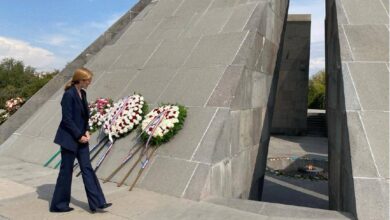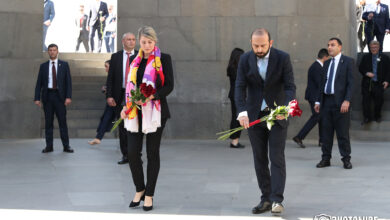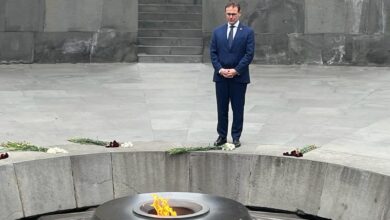
An article by Brittany Levine published by the Glendale News Press presents the story of Armenians, who move to Armenia from Glendale. The story runs, as follows:
Sevan Kabakian moved with his wife and children, who were all born in Glendale, to Armenia with a plan.
The couple knew where they’d enroll their three children in school. They knew Kabakian would have a job — working for Birthright Armenia, an organization that offers volunteer opportunities in that country for those of Armenian descent — leaving an 18-year career as an aerospace engineer behind. They knew they wanted to help build something.
“All of us who move here, we kind of want to be part of this country’s development,” said Kabakian, who moved in 2006. “It’s none of this homeland is paradise on earth. People that live here long term end up being pragmatic. There’s a desire to help, but you can’t build a nation on sentiments.”
Armenia, which has been independent from the Soviet Union since 1991, is still a country in transition, marked by high rates of emigration, unemployment and poverty. Yet outsiders with ancestral connections move there because they want to help it improve.
It doesn’t happen often, but those that do immigrate to Armenia from Glendale and the greater Los Angeles-area — one of the largest Armenian communities in the world — have similar traits. They’re idealists. They believe in a global community. They want to give back to a country they weren’t born in, but consider a homeland. And they almost always move because an opportunity presented itself.
That happened to Kabakian, 50, with Birthright Armenia, and Glendale native Alex Sardar, who got an email in 2002 about a position working for an international development organization. At 27, he had his dream job: working on democratic reform and managing a $2-million budget.
The transition was difficult for Sardar though, the idealized Armenia the now 39-year-old had grown up hearing about didn’t hold up in real life. The country had energy-supply problems, it took months to get a phone line, he found it hard to fit in and the pollution was overwhelming — even though he grew up near smog-filled Los Angeles.
But then something clicked. His job was supposed to be for two years, but he ended up staying in Armenia for nearly 12, moving just this year to Washington, D.C. for a job.
“For me in Armenia, the Armenian experience meant opportunity,” he said, adding that it put him on the path toward a leadership role at a nongovernmental organization focused on building sustainable communities in developing countries.
Difficult to count
After the Armenian Genocide in 1915 at the hands of the Ottoman Empire, Armenians scattered across the globe, building diasporan communities outnumbering the 3 million living in the country. While many are still tied to Armenia through culture and family and some talk about returning, few do.
It’s difficult to tabulate exactly how many Armenians born here move to the Central Asia nation bordered by Iran, Turkey and Georgia. RepatArmenia officials, a nonprofit founded in 2012 as a resource for Armenian immigrants, say they served 550 people between September 2012 and September 2013. Of these, 48% were Syrian-Armenians escaping the civil war, 15% were U.S. Armenians and the rest were from Russia, Lebanon and other countries.
Several Californian expatriates in Armenia prefer the term “repatriate” and compare themselves to Jews who immigrate to Israel. While the number of repatriates may not be increasing quickly, information about repatriation is, said Vartan Marashlyan, RepatArmenia’s executive director. He noted thata seminar held in December 2012 about repatriation was attended by 250 people in Los Angeles.
It’s not easy to throw away comfort and convenience to move to a developing country, but those who have from the Glendale area end up finding jobs they love, even as locals are fleeing because of a lack of work.
Serouj Aprahamian, the former executive director of the Glendale-based Armenian Youth Federation Western Region, has been living in Armenia for nearly a year. He works in public relations for a nonprofit and teaches break-dancing on the side, but he also is deeply involved in social issues. In May, he served as an election observer in the Yerevan municipal race.
“I can get paid for dance, which is difficult in the U.S., and human rights stuff is actually happening here. Things we do are affecting people’s lives,” said the 32-year-old.
For foreigners to work in the country, one needs a residency card, which Aprahamian has. He also plans to eventually get dual citizenship.
He boarded his one-way flight to Armenia in February, on the same day as his friend, Allen Yekikian from La Crescenta. Yekikian and his wife, Sosé Thomassian, only lived abroad for a few months before they died in a car crash while visiting nearby Georgia. They chronicled their experience through a blog, howtomakeitinarmenia.com, posting about politics, weather, fashion and often calling Armenia, their “homeland.”
The young couple’s deaths — she was 30, he was 28 — shocked the Glendale Armenian community, prompting memorials and YouTube tributes. Their story also inspired others to consider moving to Armenia.
“They would talk about moving our group of friends there, about how amazing that would be to just take our lives and move it over there. They would always say if we set an example then we can get people to move back,” said Hrache Novruzyan, a fashion designer from Brea who has been considering moving.
Novruzyan, who has traveled to Armenia before, said she’s ready to make the jump — despite everything she would give up — as soon as she finds a job there.
“You have to go with the mindset that you’re going to give to the country as opposed to what you can gain from the move,” the 23-year-old said. “To me, [Armenia’s] like at a toddler stage. It learned how to walk, but it needs support.”
Many repatriates consider it their duty to contribute to their new communities. Aprahamian and Sardar worked on social and political issues and Kabakian’s wife is helping establish parent-teacher associations in their local school system. Then there’s Nora Kayserian, who is deeply involved in women’s rights issues.
The 28-year-old does public relations for an Armenian nonprofit focused on crowd-funding projects, but is considering teaching self-defense classes for women instead. Women in Armenia suffer from high-rates of domestic violence and other gender issues, including sex-selective abortions, she said.
“For a woman, if you keep quiet, if you don’t talk about women’s rights, if you don’t express your opinion as a feminist, then you’re fine, no-one’s going to bother you,” Kayserian said, adding that she knows of a tight-knit group of feminists, but there’s no women’s movement yet in the true sense of the word.
One time she was discussing gender roles with a group of girls at an orphanage in Gyumri, the second largest city in Armenia. She asked them why the husband gets to be the decision maker in a household. One girl responded that men should be the head of the household and Armenia doesn’t need to adopt American values. Kayserian was surprised, but then asked the girl if that was a personal choice or a societal one. She didn’t have a response.
For some, their families support the move, but for Kayserian, who is from the Los Angeles-area, it was a struggle to get her parents to understand. They were Armenians who moved from Turkey to the United States so she could have a better life, and yet she chose to move to a developing country.
“Through showing them what I’m doing, they’re slowly starting to understand,” Kayserian said. “I’m planning to stick around and to hopefully be a part of a women’s movement when it happens here eventually.”








